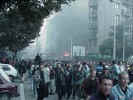|

of the Belgrade Coup
Editor & Webmaster
Leon Chame - 12/04/99
Yugoslav Associates:
- Zoran Radojicic
- Dejan Vukelic
- George Orwell
Contributing Websites:
- Original Sorces
- Transnational (TFF)
- Fair sources
- WSWS
March 03, 2003
| |
The method of distortion and without any substantiation
It is worthwhile to analyze one of the major reports on
the mass graves, which appeared on the front page of the New York Times
written by John Kifner and Ian Fisher. The report focuses on the town of Djakovica, in
southwestern Kosovo near the border with Albania, and cites claims that as many as 1,000
Albanian men were seized there by the Serbs, taken away and presumably murdered.
While the impression is given throughout the article that the events in Kosovo were the
outcome of a deliberate campaign of ethnic cleansing, driven by the genocidal hatred of
Serbs for Albanians, a number of facts are acknowledged which
suggest a different explanation.
Kifner and Fisher write: "Djakovica has long been a center of Albanian
nationalism. The whole region, known as Has on both sides of the border, is regarded by
the interrelated Albanian clans as one entity." And later: "The Kosovo
Liberation Army bases are on the other side of the craggy mountains, in lawless northern
Albania, and their supply routes run down the mountain passes into the valleys here. Thus
the town has enormous strategic importance. "Tactically, the area lies on the main
highway close to the border."
These circumstances suggest that Djakovica was a particularly brutal focus of military
conflict between the Yugoslav Army and armed KLA secessionists, the kind of civil war
which in country after country produces atrocities, especially among civilians linked to
the guerrilla fighters.
But instead of this conclusion, the Times writers add, without any
substantiation: "In the
Serbs' well-planned campaign, mass killings in the first days spread terror, emptying
villages near the borders, encouraging others to follow on the routes now cleared."
Then come four or five examples of alleged mass graves , with a total number of victims approaching 200, but with little proof that
those buried are civilians, rather than KLA fighters, or even that any bodies are buried
at all. One example is a
"patch of churned earth" pointed out by KLA soldiers who said up to 100 people
were buried there.
The choice of words throughout the article is quite conscious. Albanian deaths are the
result of "massacres." The possibility that Albanians—and Serbs—might
have been killed as the result of fighting between the KLA and Serb forces, especially in
this town of admittedly "enormous strategic importance," is nowhere raised.
The article is written as though atrocities in Kosovo come as a shock. There is a tone of moral indignation, not found, for instance, when the New
York Times writes about the deaths of Palestinians on the West Bank, or Kurds in
Turkey, or Tamils in Sri Lanka, let alone the victims of American military violence in
Iraq, Somalia or Panama.
The reports in the Times, and reports and editorial commentary throughout the
American media, routinely assert that the Milosevic
regime in Belgrade executed a deliberate plan to expel the Albanian population of Kosovo
in order to ensure Serbian control of the territory. These
claims, made without any evidence, run up against one central obstacle—the fact that
the mass flight of Albanian Kosovars did not begin until after the NATO bombing commenced
on March 24.
The US-NATO version of events is that the bombing itself played no role in the flight
of the Kosovars. Given that the bombing of Serbia itself resulted in
the displacement of an estimated one million Serb civilians—a fact virtually
unreported in the American media—that is difficult to believe.
But if one concedes, for the sake of argument, that NATO shares no responsibility for
the exodus of the Kosovo Albanians, then another conclusion must follow. Since the mass
expulsions did not get under way until after the NATO bombing started and the 2,000
observers from the Organization for Security and Cooperation in Europe (OSCE) had been
withdrawn, it follows that Milosevic's plan for "ethnic cleansing" was
predicated on the onset of an air war against his country. Indeed, to be consistent one would have to conclude that Milosevic positively
desired devastation at the hands of the US and NATO and deliberately provoked the air war, so as to
carry out his plan for ethnic cleansing under its cover.
The more one examines the claim of a Serb master plan to purge Kosovo of Albanians, the
less it holds together. Another
explanation is more persuasive. The Milosevic regime had plans for a military offensive
against the KLA, which included the forced removal of Albanian civilians in areas,
especially near the Albanian border, which were key KLA supply routes. Similar methods have been employed in virtually all
"counter-insurgency" wars of the 20th century, nowhere more brutally than by the US in Vietnam.
|


